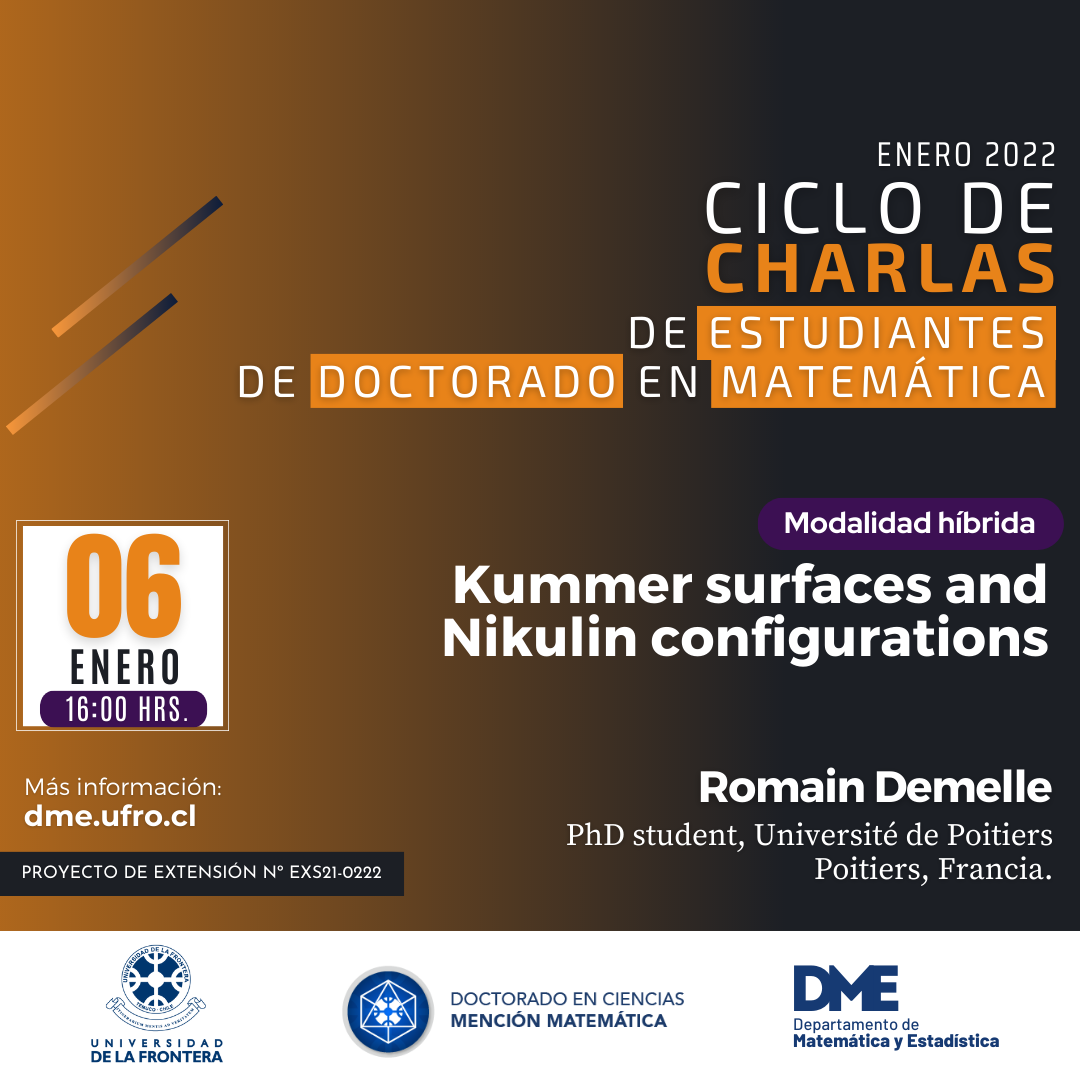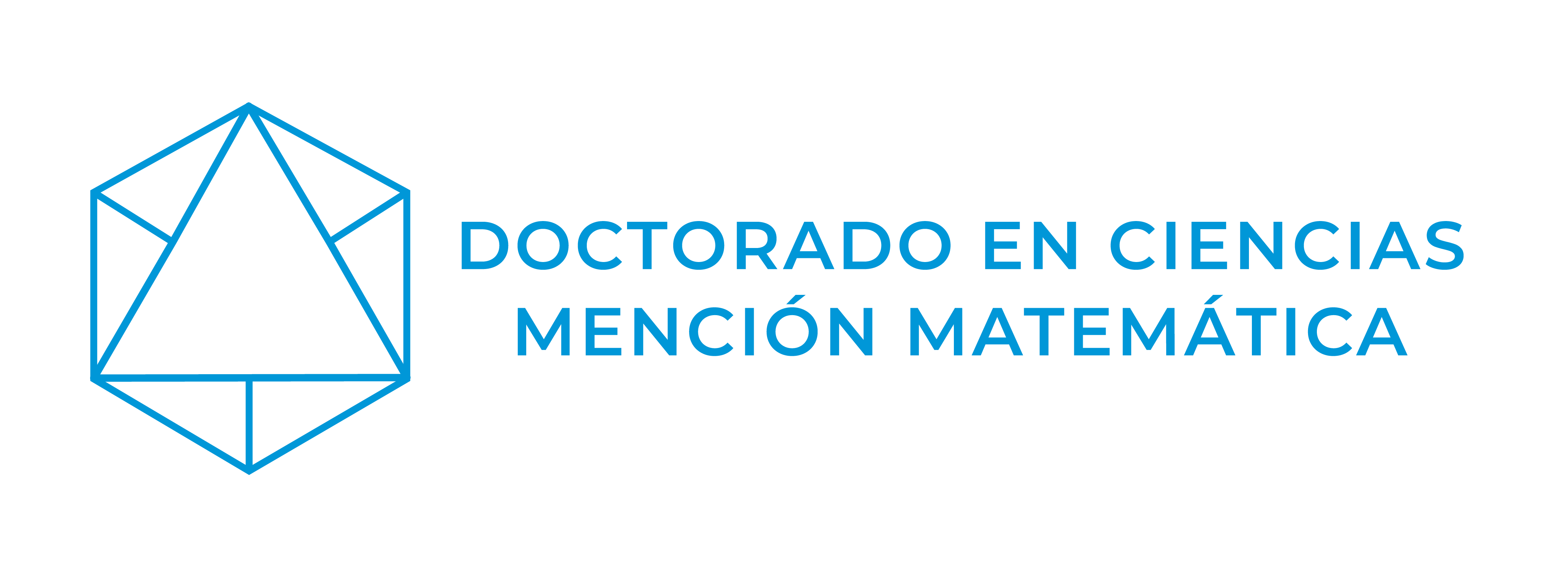Seminarios
The Seminar of the Doctoral Program in Mathematical Sciences, offered by the Universidad de La Frontera, provides a space for graduate students and faculty members—both from UFRO and other institutions—to present the progress of their respective research. These monthly sessions are jointly organized by the Doctoral Program and the Research Center Geometry at the Frontier.
Organizer 2025
María Elisa Valdés
Session 2
Friday, June 13 – 3:30 p.m.
Speaker: Carlos Asencio Pérez, PhD student in Mathematical Sciences, Universidad de La Frontera
Title: Łojasiewicz exponent in non-degenerate deformations of singular surfaces
ABSTRACT:
This talk focuses on the study of the Łojasiewicz exponent, an analytic invariant whose potential topological invariance has been the subject of research for decades. We present a detailed review of the result proved by Brzostowski, Krasiński, and Oleksik (2021), which confirms its constancy within families of functions under certain conditions. To this end, we develop the necessary theoretical tools, reconstruct omitted proofs from the original paper, and provide an illustrative example. This analysis not only clarifies the proof but also lays the groundwork for future studies on the nature of the exponent.

Session 1
Friday, March 14 – 11:30 a.m.
Speaker: Daniel Bravo Vivallo, Institute of Physical and Mathematical Sciences, Universidad Austral de Chile
Title: Math outreach without nonsense: Rigor, communication and validation
ABSTRACT:
Mathematics outreach and communication have become an essential part of my academic work. Beyond sharing knowledge, I view mathematical outreach as a responsibility and a way to contribute to the development of a society better equipped to understand the world it has built. However, doing this effectively requires striking a balance between rigor and accessibility, avoiding empty simplifications or imprecise explanations.
In this talk, we will reflect on how to engage in meaningful math outreach without sacrificing the depth and substance of the content. We will explore strategies for communicating clearly without abandoning rigor, the role of analogies, and the use of creativity in building effective messages. Additionally, we will discuss a key aspect: validation and recognition in mathematical outreach. Who is entitled to speak about mathematics in outreach settings? How is credibility and recognition achieved? We will examine the role of mathematical training, experience in communication, and the development of competencies in science communication.
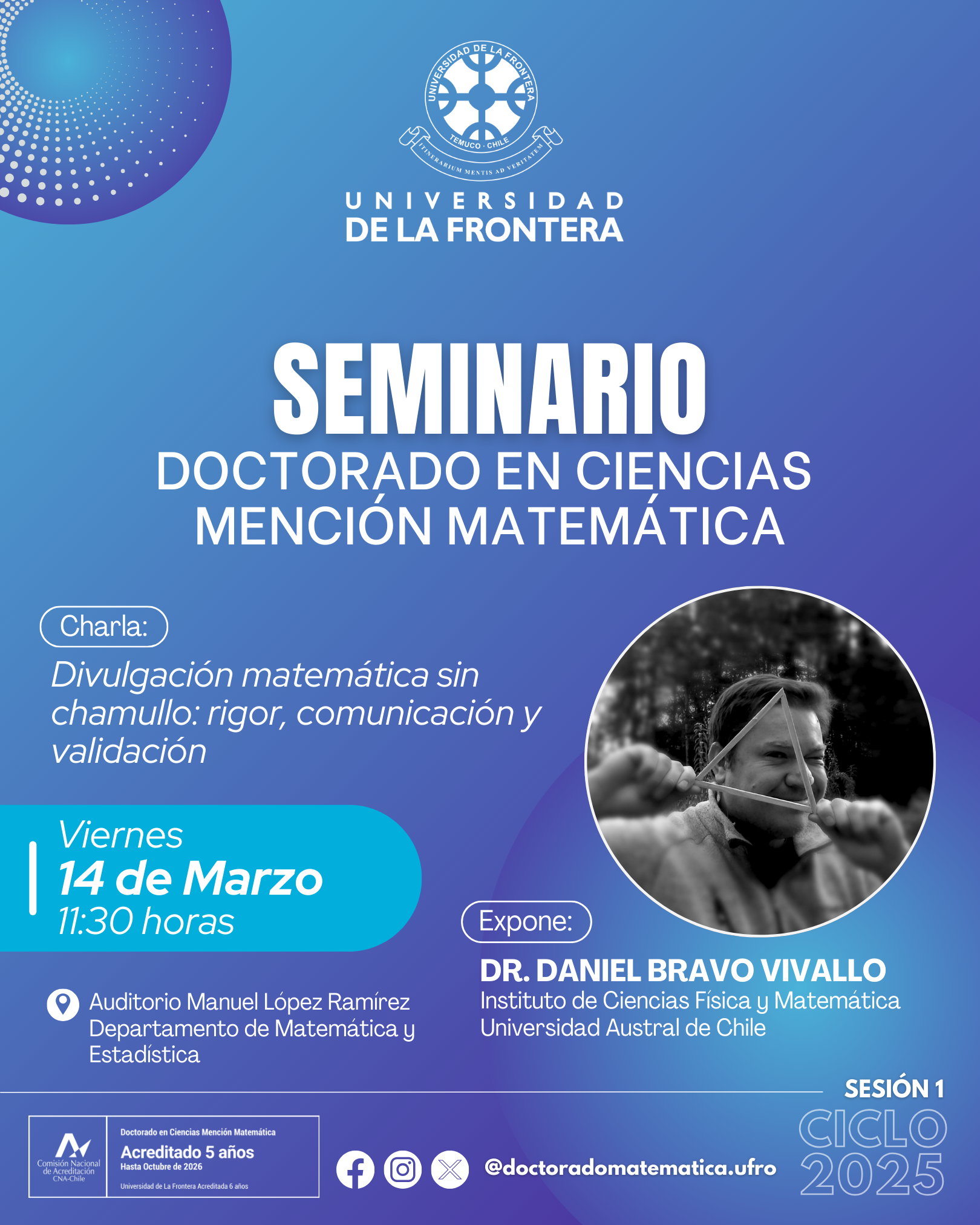
Organizers 2024
Víctor Valdebenito – María Elisa Valdés
Session 4
Friday, November 15 – 3:00 p.m.
Speaker: Mauricio Bustamante, Faculty of Mathematics, Pontificia Universidad Católica de Chile
Title: Mapping class groups of exotic Tori and actions of SL(d,ℤ)
ABSTRACT:
Exotic tori are differentiable manifolds that are homeomorphic but not diffeomorphic to a torus (i.e., a finite product of circles). Given an exotic torus of dimension d, there is a natural homomorphism from its mapping class group to SL(d,ℤ), induced by the action on the fundamental group. In this talk, I will explain when this is a surjective homomorphism that splits. As an application of this result, I will provide examples of exotic tori that do not admit any non-trivial smooth action of SL(d,ℤ).
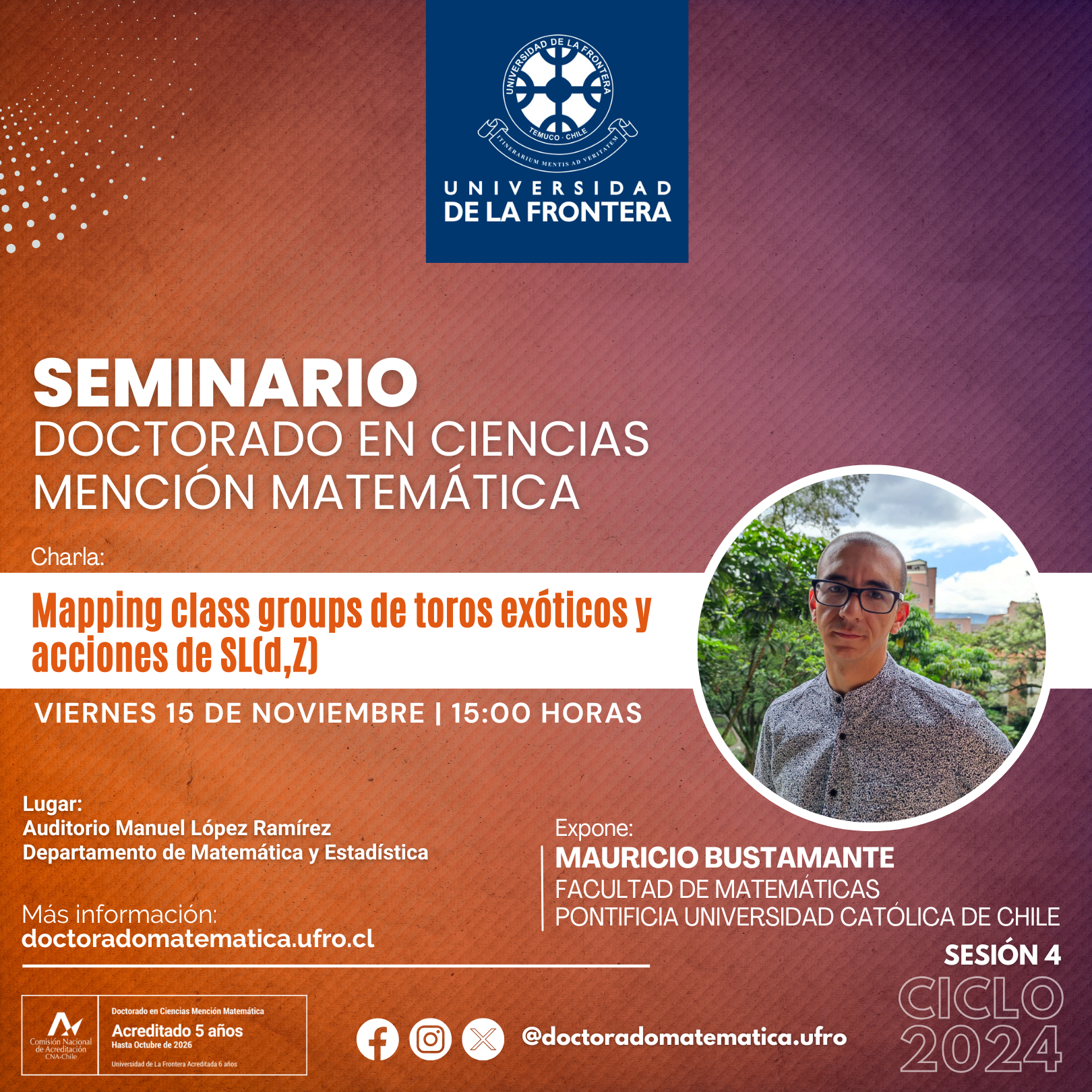
Session 3
Friday, September 6 – 3:00 p.m.
Speaker: Javier Lorca, Department of Physical Sciences, Universidad de La Frontera
Title: Higher-order Abelian quantum double models: Characterization and classification of the ground state subspace
ABSTRACT:
In the literature, it has been shown that higher-order Abelian quantum double models are valid in all finite dimensions and exhibit the characteristic behavior of symmetry-protected topological (SPT) phase models. In this talk, we provide a pedagogical introduction to the formalism of these models, with an emphasis on the dualization procedure that fully characterizes the ground state subspace, and briefly present a new classification result. We also discuss the connection of these models to pressing problems in condensed matter physics and quantum computing.
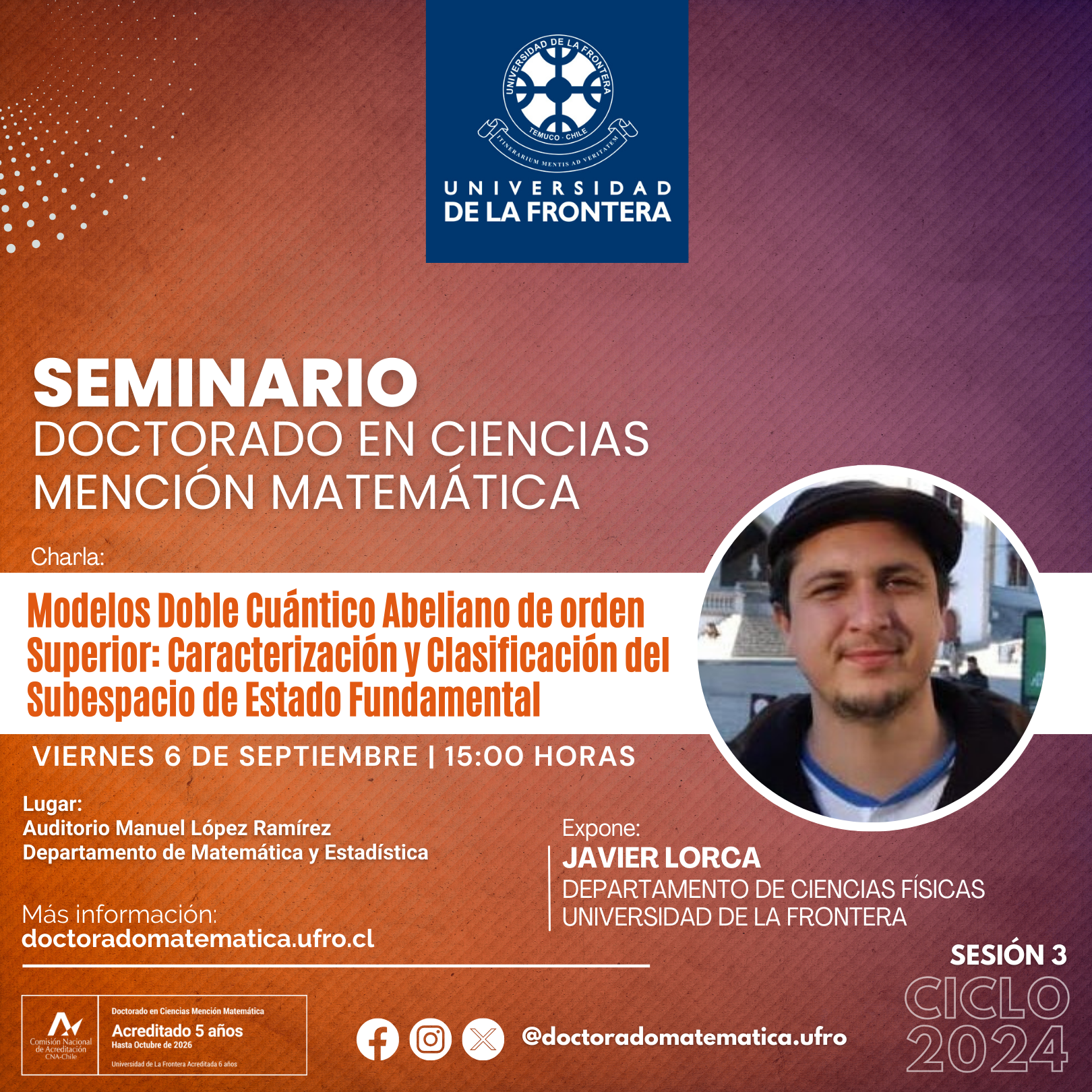
Session 2
Friday, May 24 – 3:00 p.m.
Speaker: Daniel Pellicer, National Autonomous University of Mexico
Title: On crystalline structures and rank-4 combinatorial objects
ABSTRACT:
According to crystallographers, there are only five regular crystallographic lattices. These lattices display a high degree of symmetry and naturally appear in nature. They also emerge in mathematics as interesting examples.
In Euclidean space, there is only one regular tessellation: the tessellation with cubes. This is the only tessellation that exhibits all possible rotational symmetries and is also symmetric under reflections. If we relax the definition of tessellation using the version introduced by Grünbaum in the second half of the 20th century, three new objects appear that admit all possible combinatorial rotations but no reflections. These objects are closely related to regular crystallographic lattices. Two of these objects will be presented.
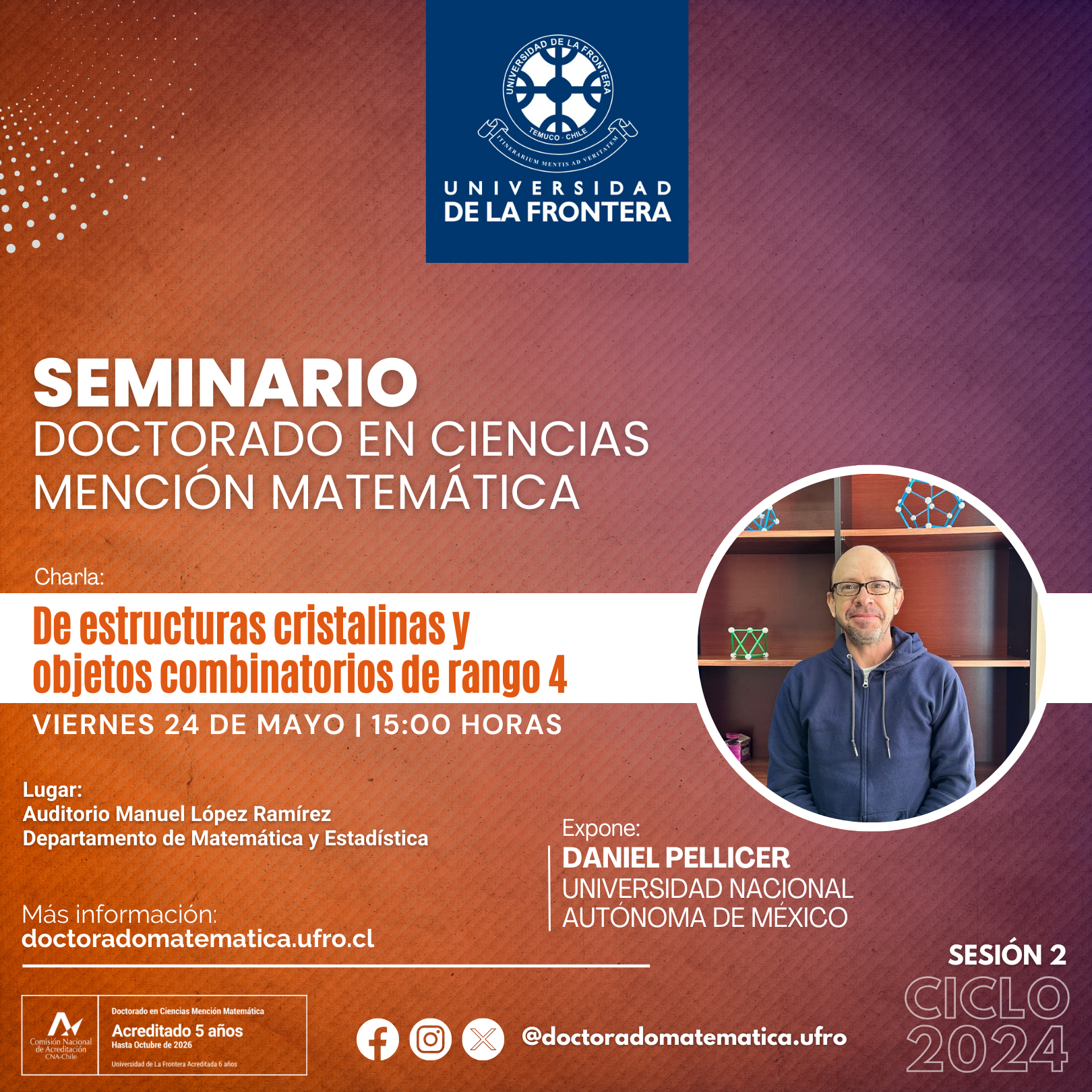
Session 1
Friday, April 5 – 3:00 p.m.
Speaker: Daniel Parra Vogel, Universidad de La Frontera, Chile
Title: A topological version of Levinson's theorem
ABSTRACT:
In this talk, we will begin by introducing the basic objects of quantum scattering theory. We will then show how the C*-algebraic formalism allows us to relate the study of bound states of a scattering system with the K-theory of certain C*-algebras associated with it. We will conclude by presenting examples of quantum scattering systems to highlight the advantages of this topological approach.
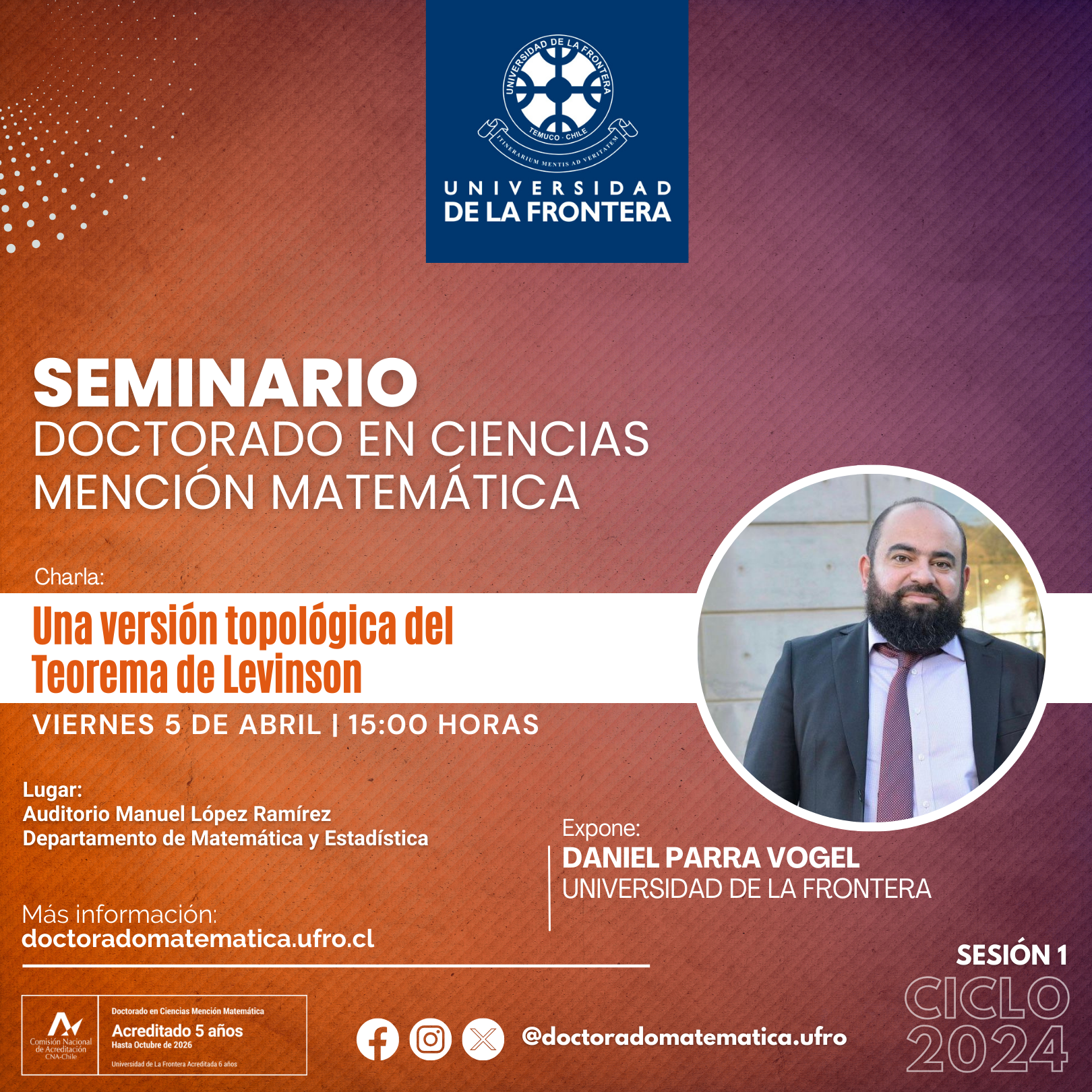
Organizers 2023
María Elisa Valdés – Pablo Quezada
Session 7
Friday, November 17 – 3:00 p.m.
Speaker: Martina Monti, Università degli Studi di Milano, Italy
Título: Automorphisms and quotients of Calabi-Yau threefolds of type A
ABSTRACT:
Calabi-Yau manifolds of type A provide an interesting setting in which it’s possible to study relations between Calabi-Yau manifolds and Abelian varieties, indeed they are defined as the quotient of an abelian variety A by a free action of a finite group G. In dimension 3 there is a full classification of these manifolds: the only possibilities for the group G are (Z/2Z)^2 and D_4 the dihedral of order 8. The aim of this talk is to present the results concerns the full classification of automorphism groups and quotients of the Calabi-Yau 3folds of type A. First, we introduce the two possible (irreducible) families of these manifolds that appear in dimension 3 and briefly recall the construction. Then, we move to the classification of automorphisms group of such Calabi-Yau 3folds providing also a result that characterizes the automorphism group of Calabi-Yau manifolds of type A. Finally, we only state the result about the quotients of the Calabi-Yau 3folds A/D_4 pointing out some consequences.

Session 6
Tuesday, October 31 – 4:30 p.m.
Speaker: Camilo Ramírez Maluendas, Universidad Nacional de Colombia, Manizales Campus
Title: On Veech groups of infinite superelliptic curves
ABSTRACT:
In this talk, we study infinite superelliptic curves as translation surfaces, which are branched coverings of the complex plane with infinitely many branch points. We provide a characterization of the Veech group of such surfaces in terms of matrices in GL<sub>+</sub>(2, ℝ), arising from the differential of affine diffeomorphisms of ℂ that permute the branch points. We obtain necessary and sufficient conditions to ensure that the Veech group of an infinite superelliptic curve is uncountable. A trichotomy is established in the set of holonomy vectors, and we give a precise description of some countable groups that can arise as Veech groups of infinite superelliptic curves via this trichotomy. We also construct and analyze various interesting examples of infinite superelliptic curves that illustrate our results.
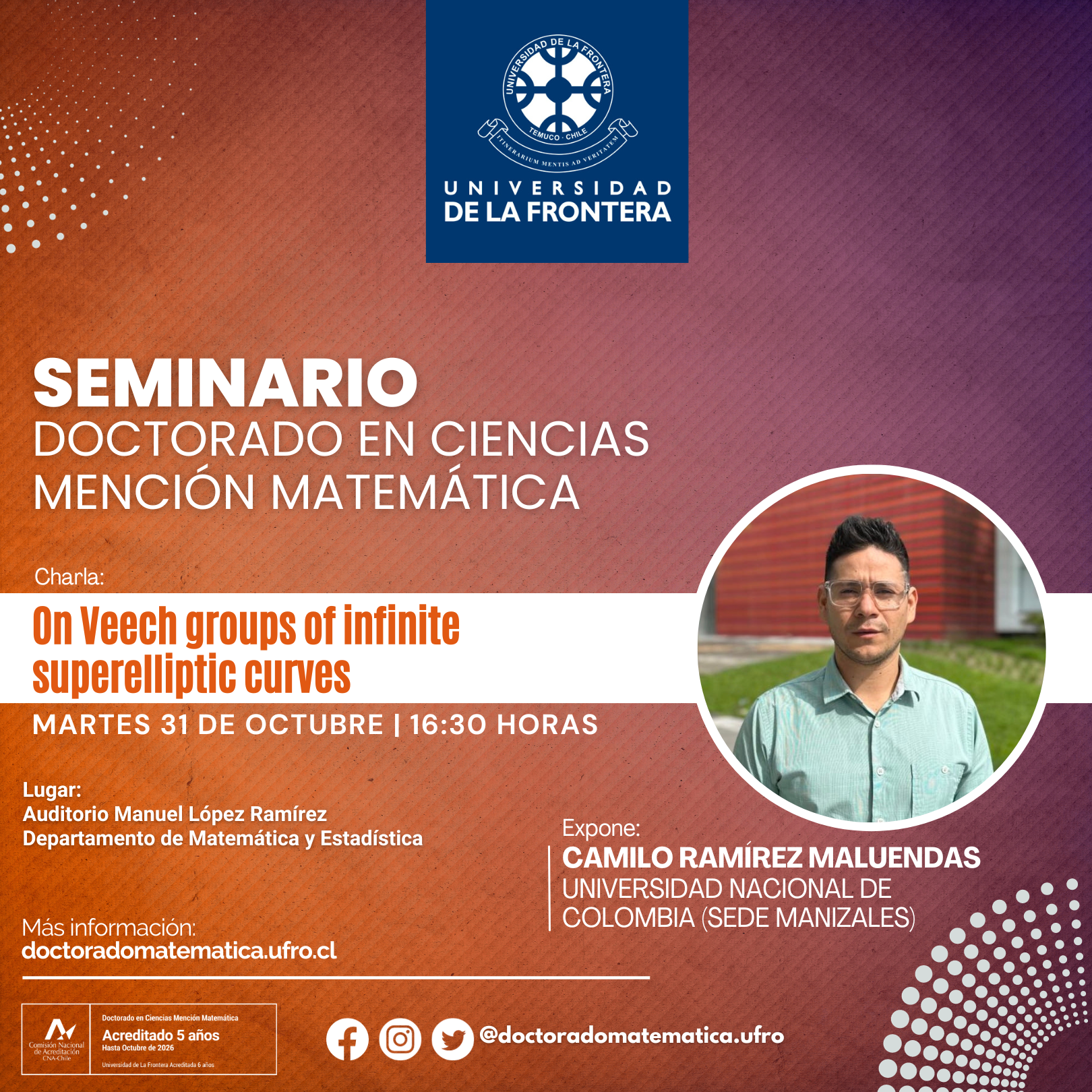
Session 5
Friday, September 1 – 3:00 p.m.
Speaker: Rodrigo Lambert, Federal University of Uberlândia, Brazil
Title: RNA sequences, gossip, and limit theorems
ABSTRACT:
One of the main purposes of science is to develop models that help us better understand natural phenomena. When such events involve some level of randomness, probability theory provides us with a very useful set of tools.
In this talk, we will explore several examples of how studying probabilistic limit theorems can enhance our understanding of well-known scientific problems. On one hand, we will address a classic case involving matches in RNA sequences in biology and repetitions of binary code fragments in information theory. On the other hand, we will illustrate how these results apply to diffusion models—such as the spread of viruses or gossip, to name two examples.
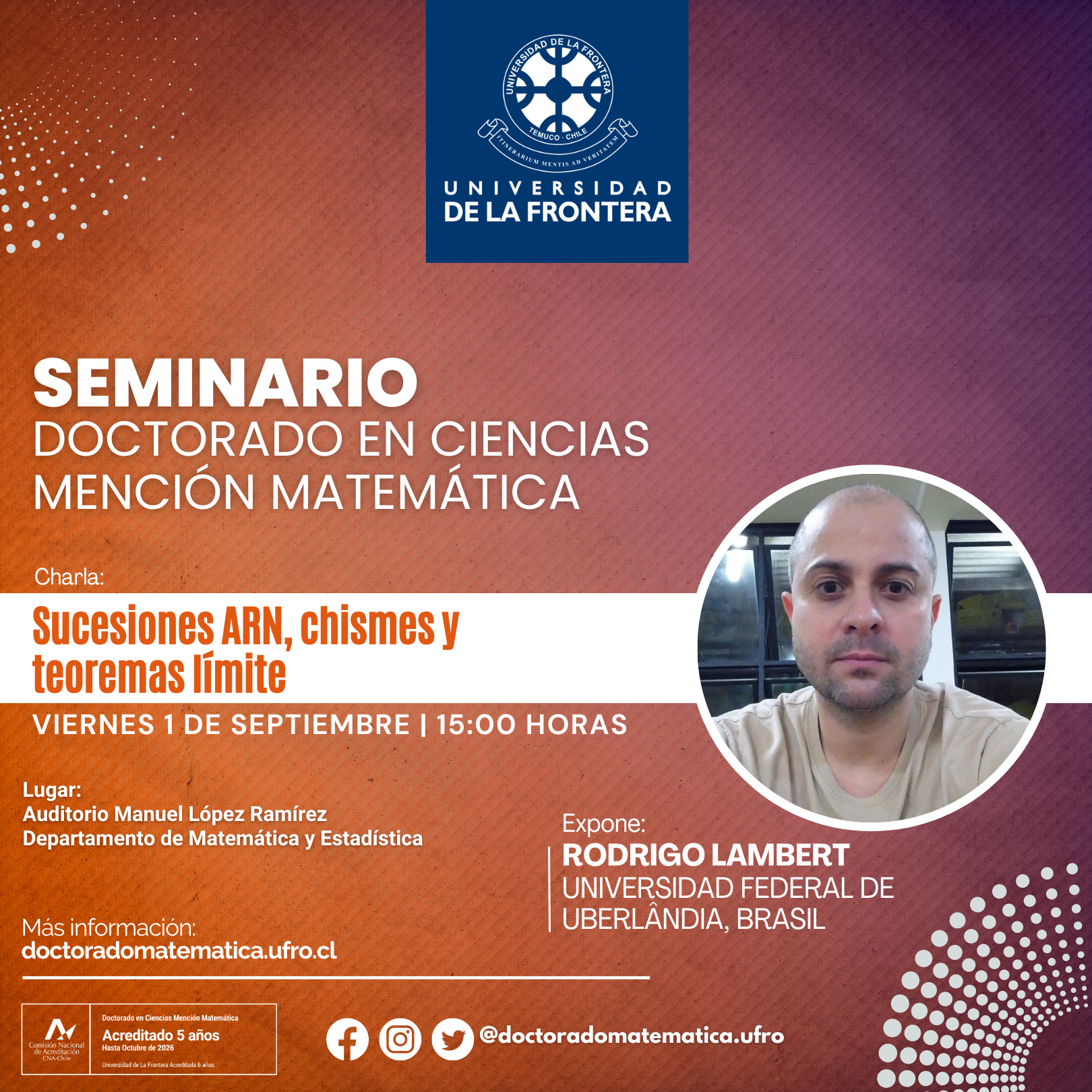
Session 4
Friday, August 18 – 3:00 p.m.
Speaker: Daniel Pellicer, National Autonomous University of Mexico (UNAM)
Title: Regular Euclidean tessellations in n dimensions
ABSTRACT:
In this talk, we will discuss regular tessellations that generalize those formed by equilateral triangles, squares, and regular hexagons to Euclidean spaces of dimensions greater than 2. Along the way, we will also talk about the candidates to serve as tiles in such tessellations, namely the so-called convex regular polytopes.
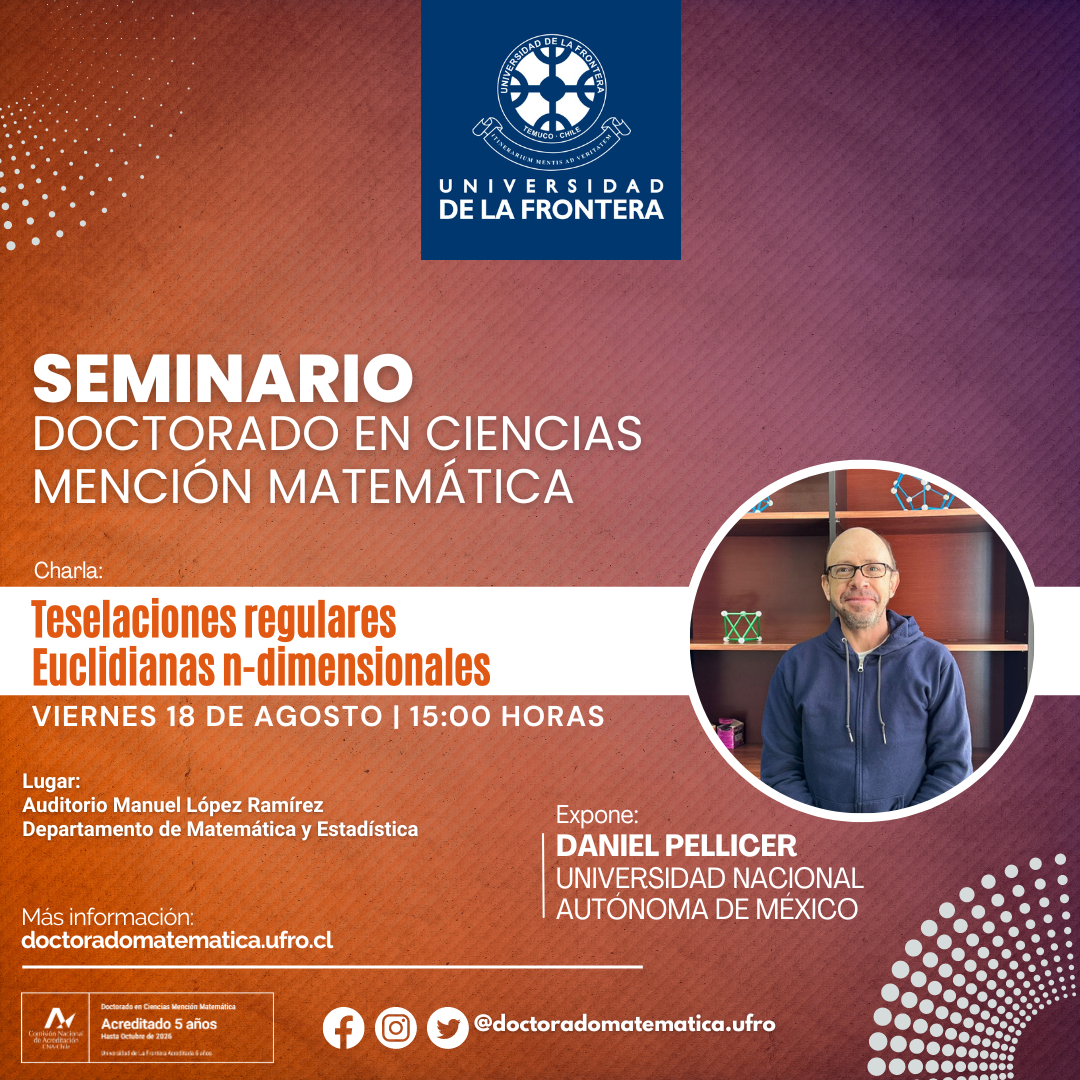
Session 3
Friday, June 30 – 3:00 p.m.
Speaker: Robert Auffarth, University of Chile
Title: Moduli: The Maps of Mathematics
ABSTRACT:
If we ever find ourselves in unfamiliar territory, a map helps us understand the area and make appropriate decisions to avoid getting lost. Similarly, moduli spaces are spaces that allow us to “locate” and understand certain mathematical objects we want to study in more detail. These spaces let us navigate and explore such collections of objects in the same way Ferdinand Magellan once navigated and explored the strait that now bears his name. In this talk, we will look at some examples of moduli spaces and explore their role in modern mathematical research.
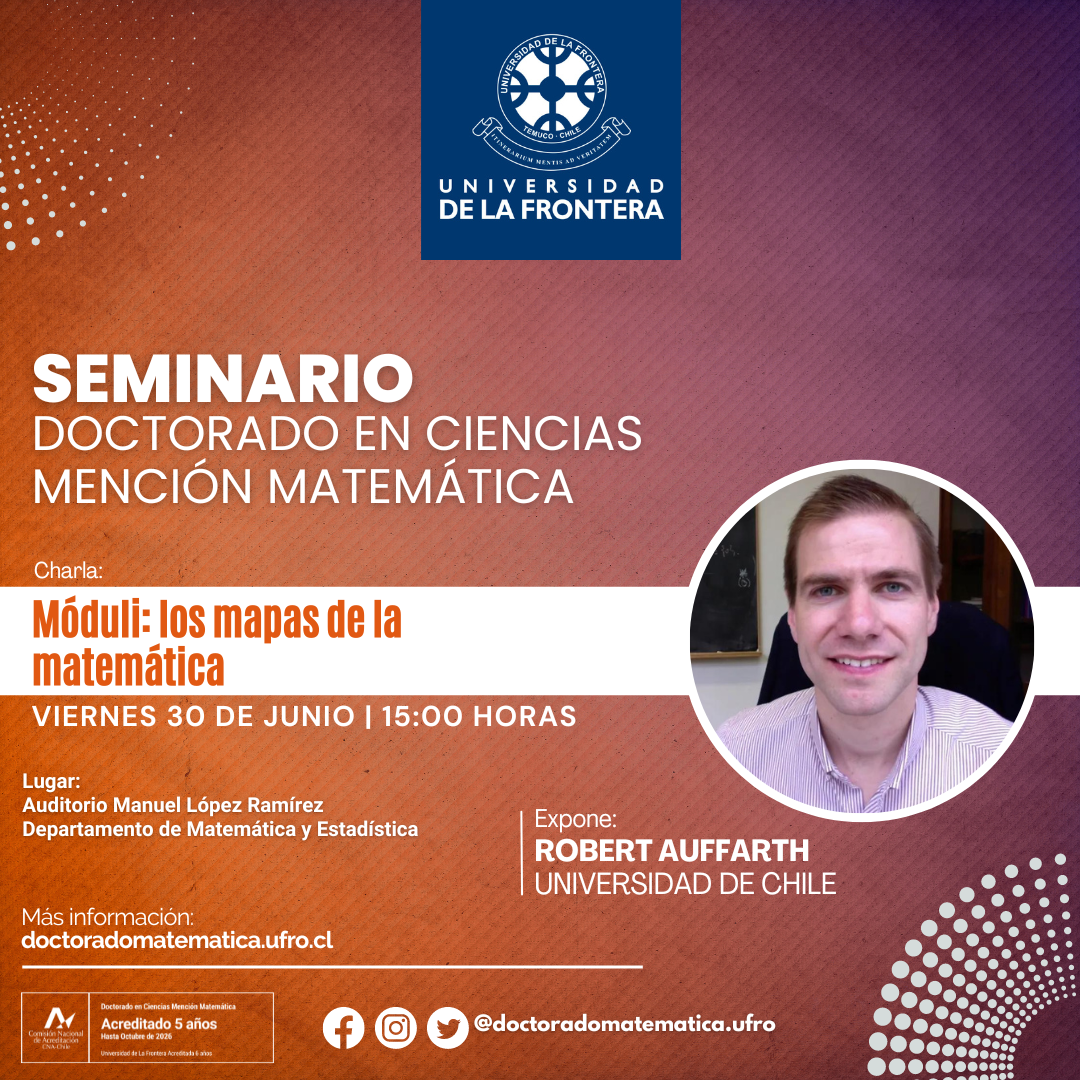
Session 2
Friday, June 16 – 3:00 p.m.
Speaker: Manuel González Navarrete, Universidad de La Frontera
Title: Two basic models from statistical physics
ABSTRACT:
In this talk, I will discuss an Ising model with an alternating external field. The goal is to present some tools used to characterize the low-temperature phase diagram. Additionally, I will introduce a family of random walks with memory, inspired by the so-called elephant random walk. I will focus on the asymptotic behavior of the walker's position.
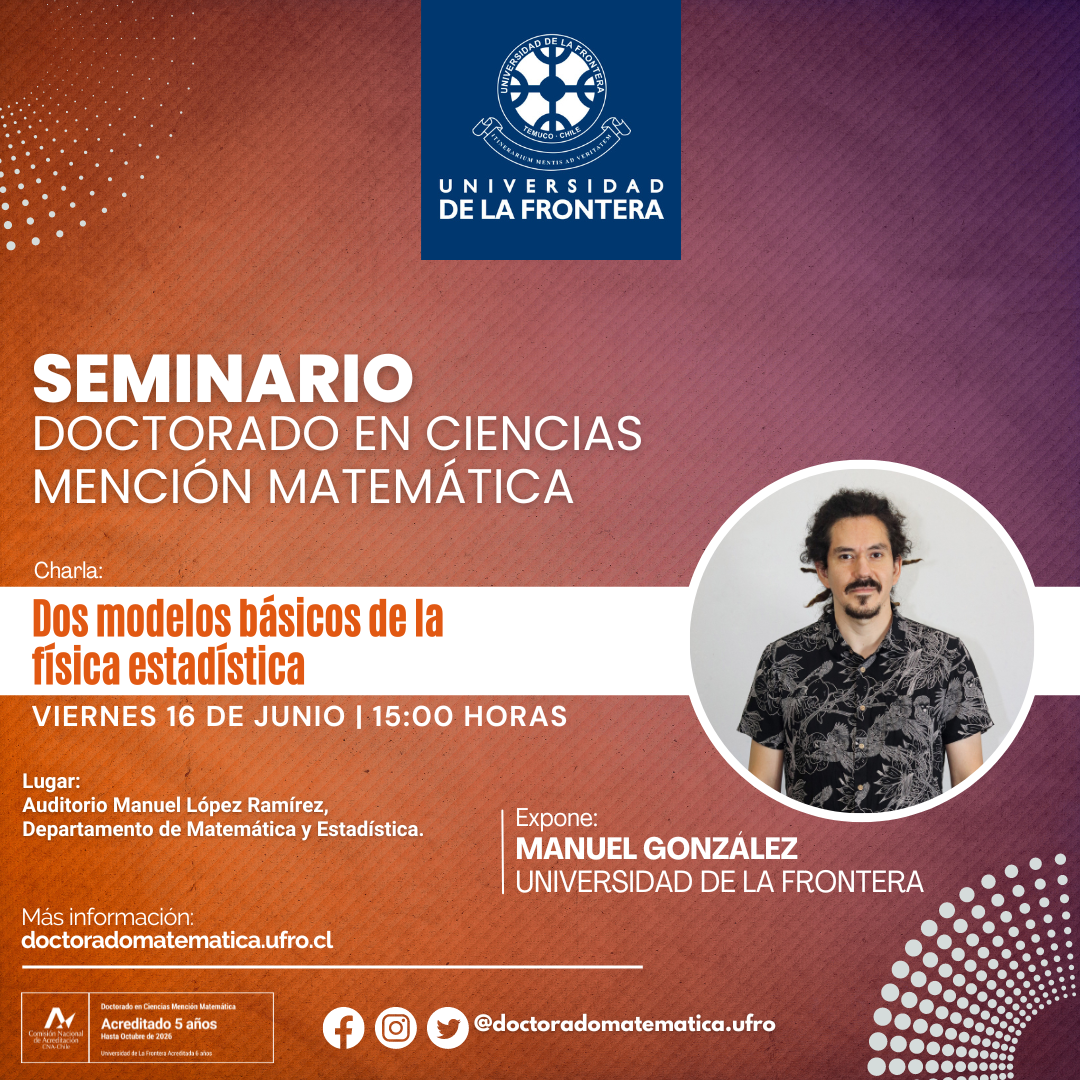
Session 1
Friday, May 19 – 3:30 p.m.
Speaker: Manuel Concha Moraga, Universidad de Talca
Title: Pieri rules for macdonald polynomials in superspace
ABSTRACT:
Symmetric functions play a fundamental role in various areas of mathematics, such as combinatorics, representation theory, and physics. Three decades ago, Macdonald polynomials were introduced, generalizing many important bases in the theory and possessing rich combinatorial properties. Recently, a generalization of Macdonald polynomials in superspace has been developed, where these new polynomials depend on anticommuting variables. It has been observed that these polynomials also retain combinatorial properties that naturally extend those of the classical Macdonald polynomials.
In this talk, we will present the combinatorial properties of these polynomials, with particular emphasis on the Pieri rules discovered for Macdonald polynomials in superspace.
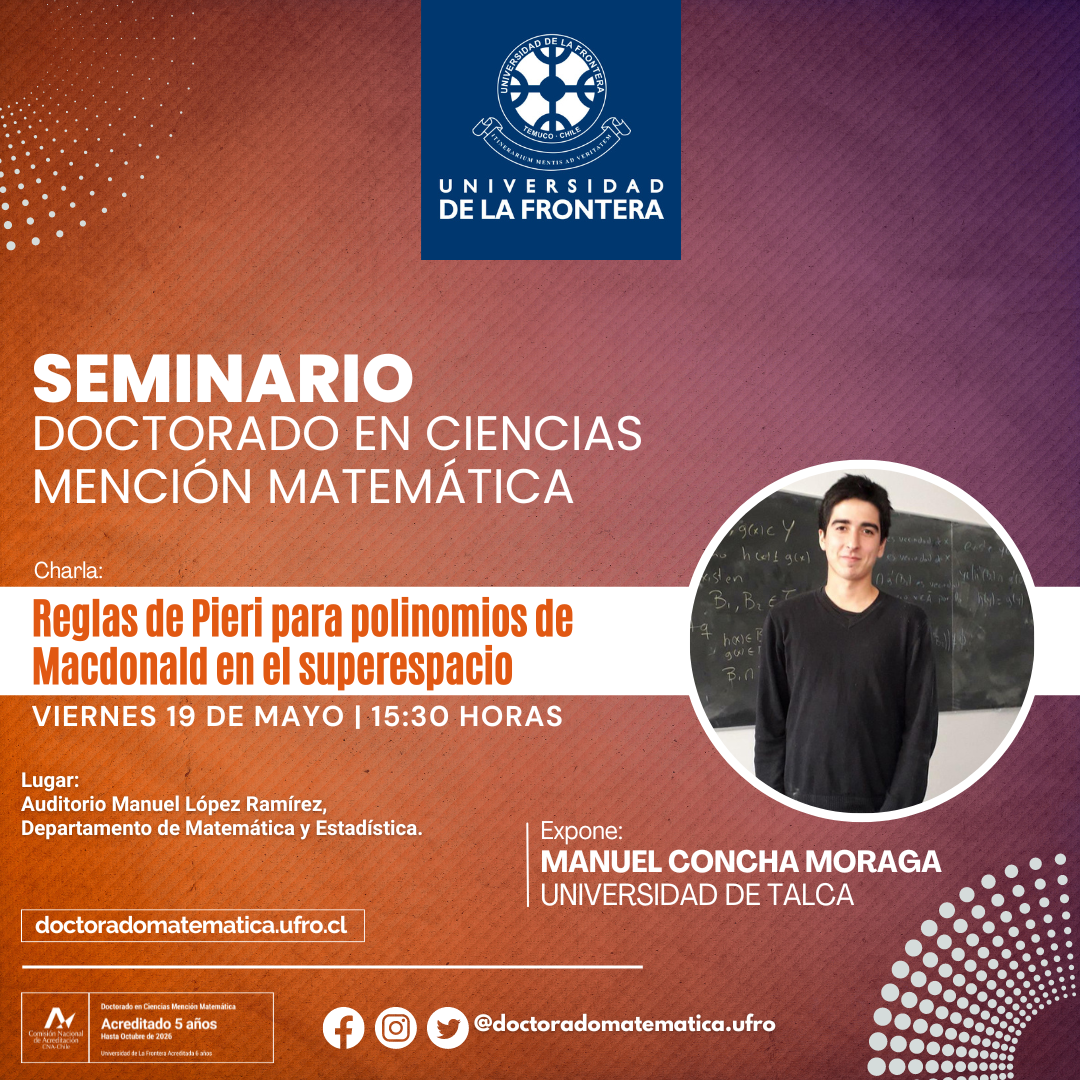
Workshop
Tuesday, January 10 – from 12:00 p.m.
Pablo Quezada Mora
(Universidad de La Frontera)
Title: Higher order extensions of the symplectic group acting on a K3^[2] manifold
Dr. Martin Raum
(Chalmers Technical University – Sweden)
Title: Ramanujan-type congruences in the theory of modular forms.
Abstract: We will discuss some recent results on Ramanujan-type congruences for modular forms. Expanding on results from the 2000s, these show, on the one hand, that such congruences appear in sets that are torsors for unit groups, and on the other hand, that they impose restrictions on possible congruences. We will illustrate these results in the case of integer partitions and toric modular forms, which are associated with toric fans and degree functions on them.Dr. Sebastián Herrero
(Pontificia Universidad Católica de Valparaiso)
Title: Asymptotic distribution of CM points
Abstract: A CM point in the moduli space of complex elliptic curves represents a curve with complex multiplication (i.e., with a larger-than-usual endomorphism ring). A classical theorem by William Duke (1988), later extended by Laurent Clozel and Emmanuel Ullmo (2004), establishes the equidistribution of CM points in this moduli space as the discriminant of the endomorphism ring (a numerical invariant) increases. Since CM points are algebraic, it is possible to study p-adic analogues of this phenomenon. In this talk, I will explain the aforementioned classical results and present a description of the distribution of CM points in the p-adic context. This is a joint work with Ricardo Menares (PUC) and Juan Rivera-Letelier (University of Rochester).
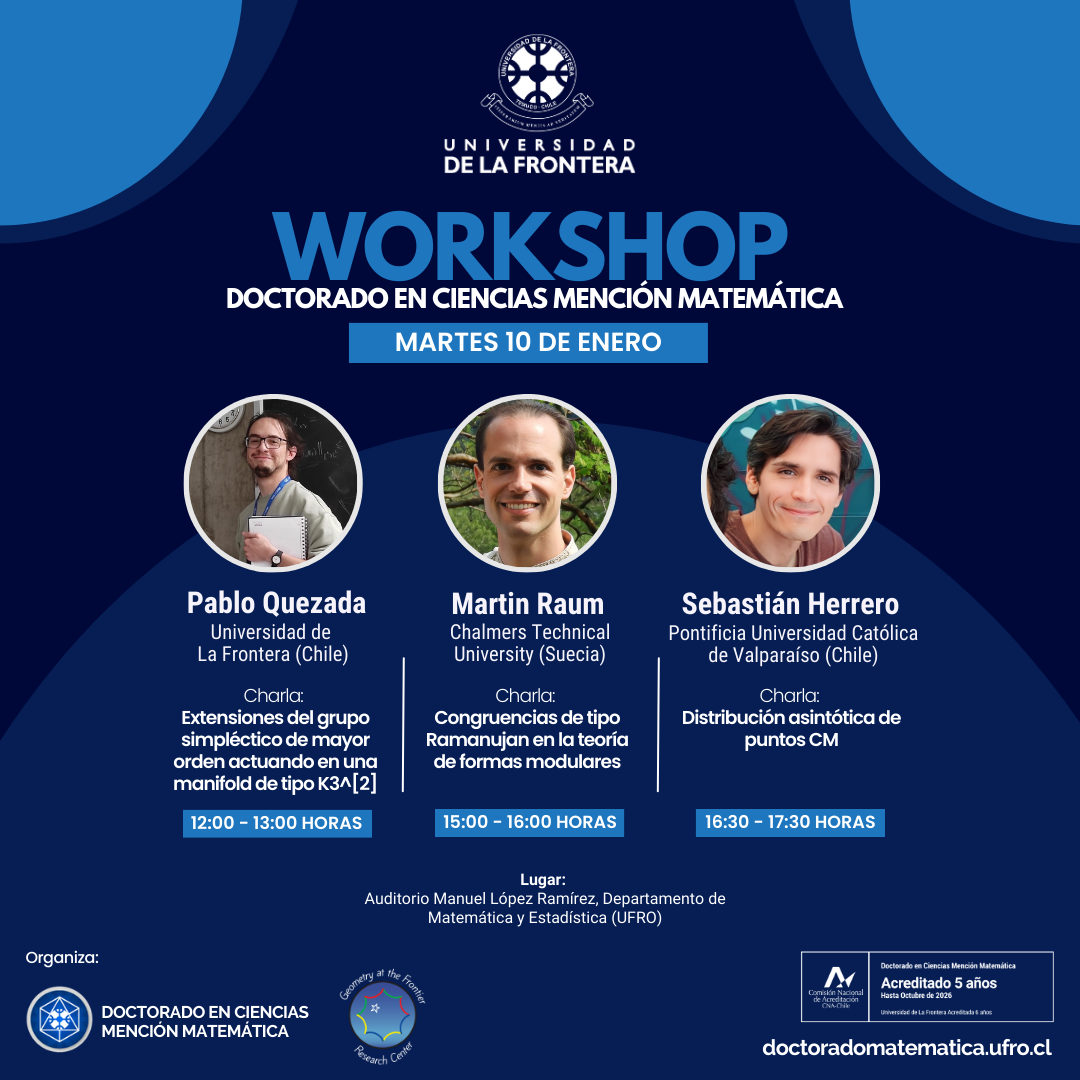
Organizers 2022
Mauricio Godoy Molina – Ignacio Castillo Bello
Session 7
Tuesday, December 6 – 4:00 p.m.
Speaker: Leticia Brambila Paz, CIMAT, Mexico
Title: Subvarieties of the moduli space
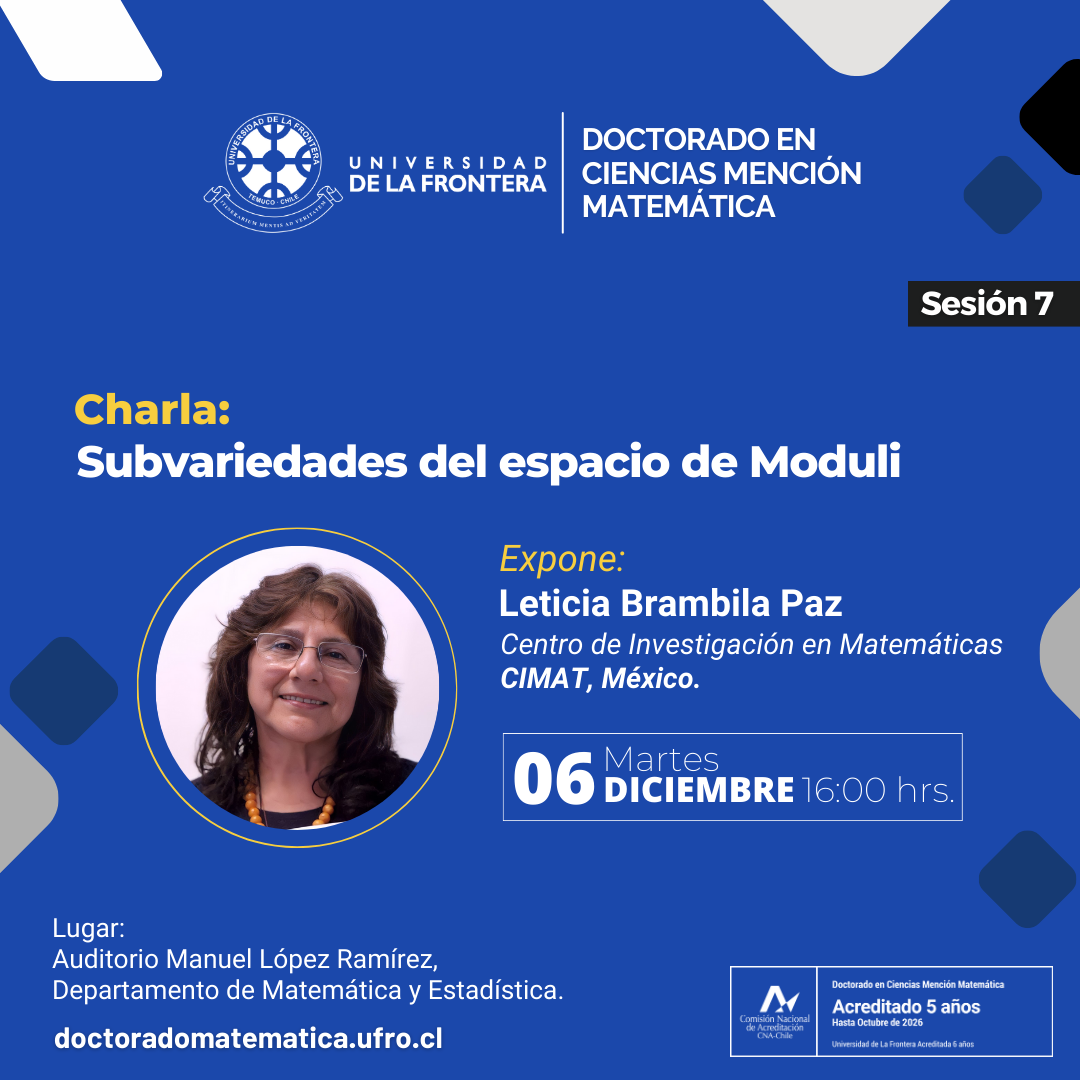
Session 6
Wednesday, October 26 – 10:30 a.m.
Speaker: Samuel Boissière, University of Poitiers, France
Title: Degenerations of IHS manifolds with automorphism: part II

Session 5
Monday, October 24 – 4:00 p.m.
Speaker: Alessandra Sarti, University of Poitiers, France
Title: Degenerations of IHS manifolds with automorphism: part I
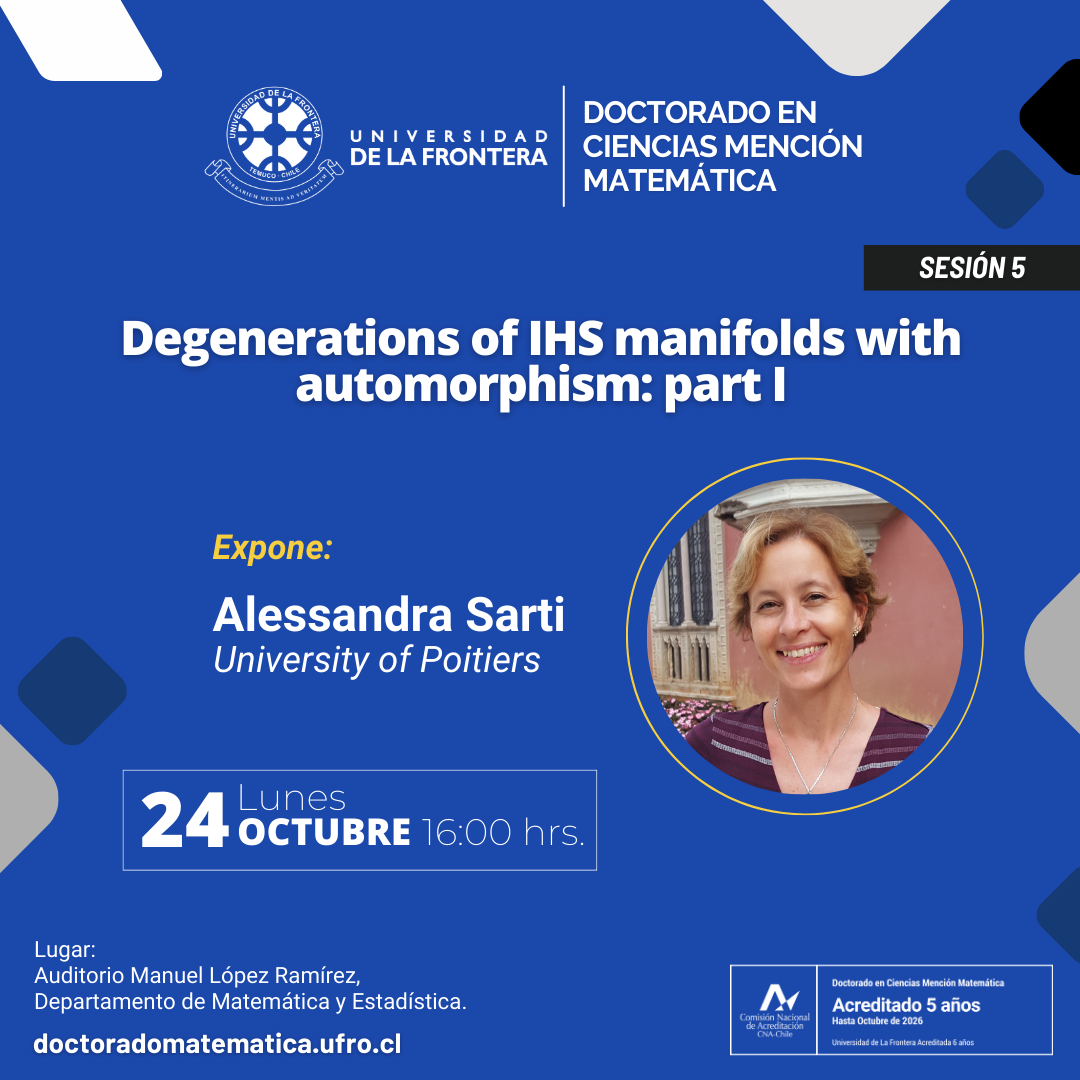
Session 4
Friday, September 23 – 4:00 p.m.
Speaker: María Elisa Valdés, Universidad de La Frontera
Title: Classification of non-symplectic automorphisms of K3 surfaces
ABSTRACT:
A finite-order automorphism n≥2n≥2 of a complex projective K3 surface is called non-symplectic if its action on the space of holomorphic 2-forms is nontrivial, and purely non-symplectic if such action has exact order nn. According to [1], the rank of the transcendental lattice of a K3 surface with a purely non-symplectic automorphism of order nn is divisible by Euler’s totient function φ(n)φ(n). This implies that φ(n)≤21φ(n)≤21, and every positive integer n≠60n=60satisfying this condition turns out to be the order of some non-symplectic automorphism.
There exists a classification of purely non-symplectic automorphisms for all prime orders, for the case φ(n)=20φ(n)=20, when the automorphism acts on the Néron–Severi lattice and φ(n)φ(n) equals the rank of the transcendental lattice, and for orders 6, 16, 9, and 4, 8 (the latter include partial classifications). When the automorphism has prime order, its invariant lattice in H2(X,Z)H2(X,Z) is p-elementary, which simplifies their classification through lattice theory, since p-elementary lattices are already classified.
On the other hand, the classification of composite-order automorphisms is subtler and requires geometric arguments, as in the cases of orders 15, 20, 22, 24, and 30. In this presentation, we will introduce the general concepts behind the classification of these automorphisms, provide examples, and discuss future conjectures.
[1] V. V. Nikulin, Finite groups of automorphisms of Kählerian K3 surfaces, Trudy Moskov. Mat. Obshch. 38 (1979), 75–137.
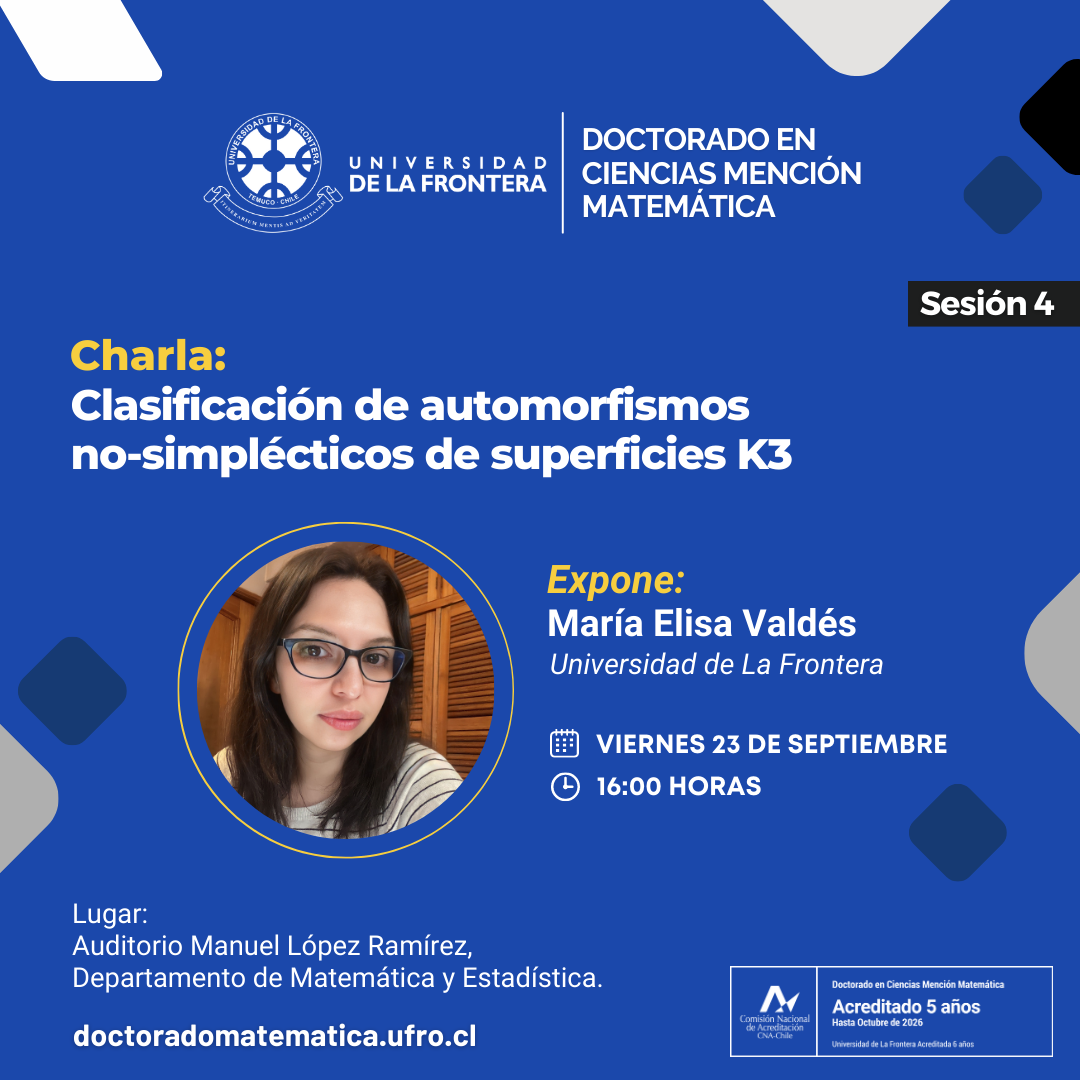
Session 3
Friday, August 5 – 10:00 a.m
ABSTRACT:
In the context of discrete-time continuous dynamical systems, the notion of perturbation has become an important tool for describing interesting dynamical properties such as genericity and stability. For discontinuous dynamical systems, defining a metric on the space of endomorphisms that induces useful perturbations for the description of dynamical phenomena remains a significant challenge. Some authors choose to work with perturbations that are not part of a topology, directly with parametrized families of systems, or with measurable concepts that do not rely on any notion of proximity between dynamical systems.
In this talk, we will discuss a new concept of perturbation on the space of piecewise continuous interval maps, which is induced by a metrizable topology on the function space. To justify our choice of metric, we will present some interesting results and concepts that can be defined on this space. We will discuss the existence of invariant measures, the persistence of non-degenerate critical points, topological genericity, structural stability, and a new concept of topological entropy that is preserved under conjugation in this context. Finally, we will mention some open questions that may be of interest to the audience.
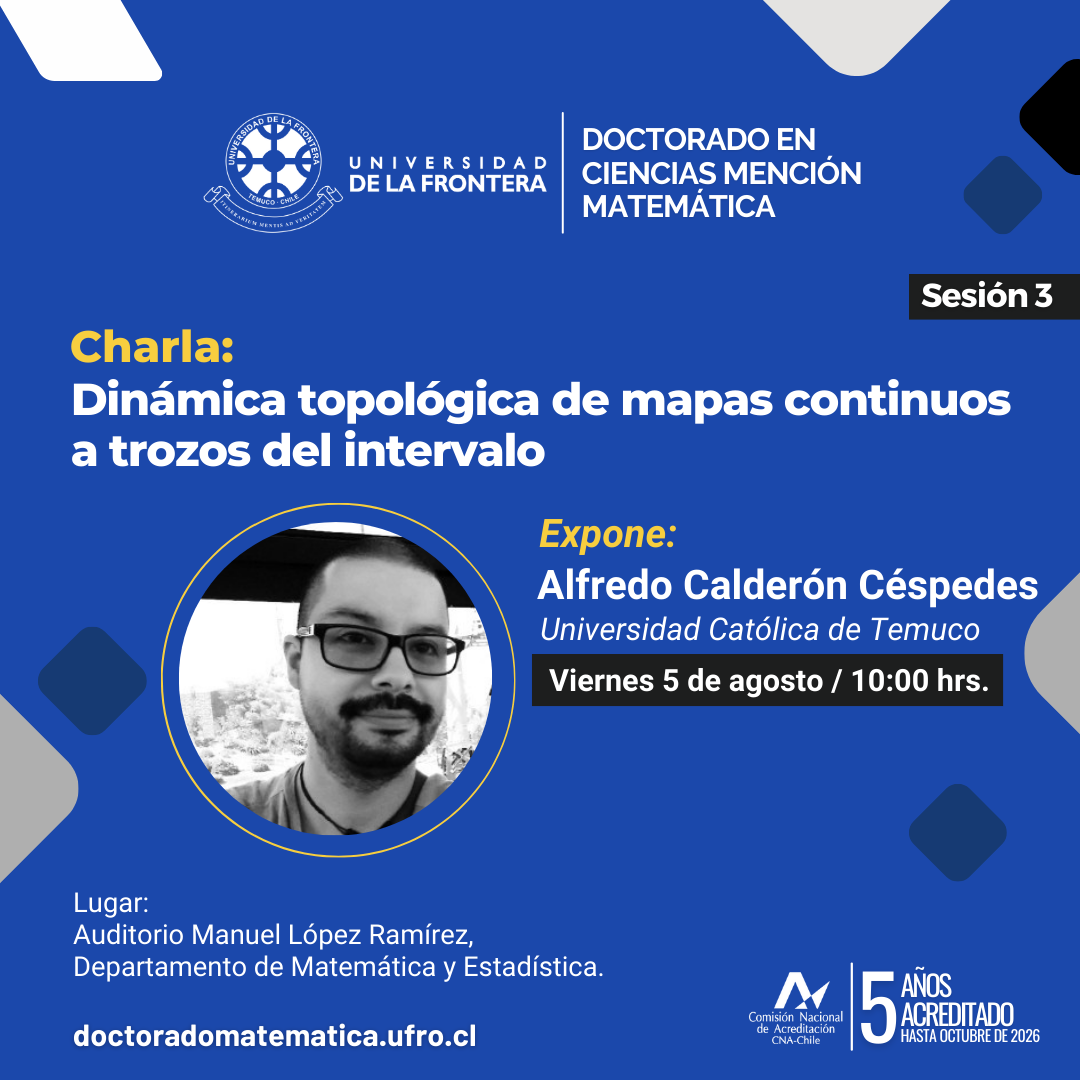
Session 2
Friday, July 1 – 10:00 a.m.
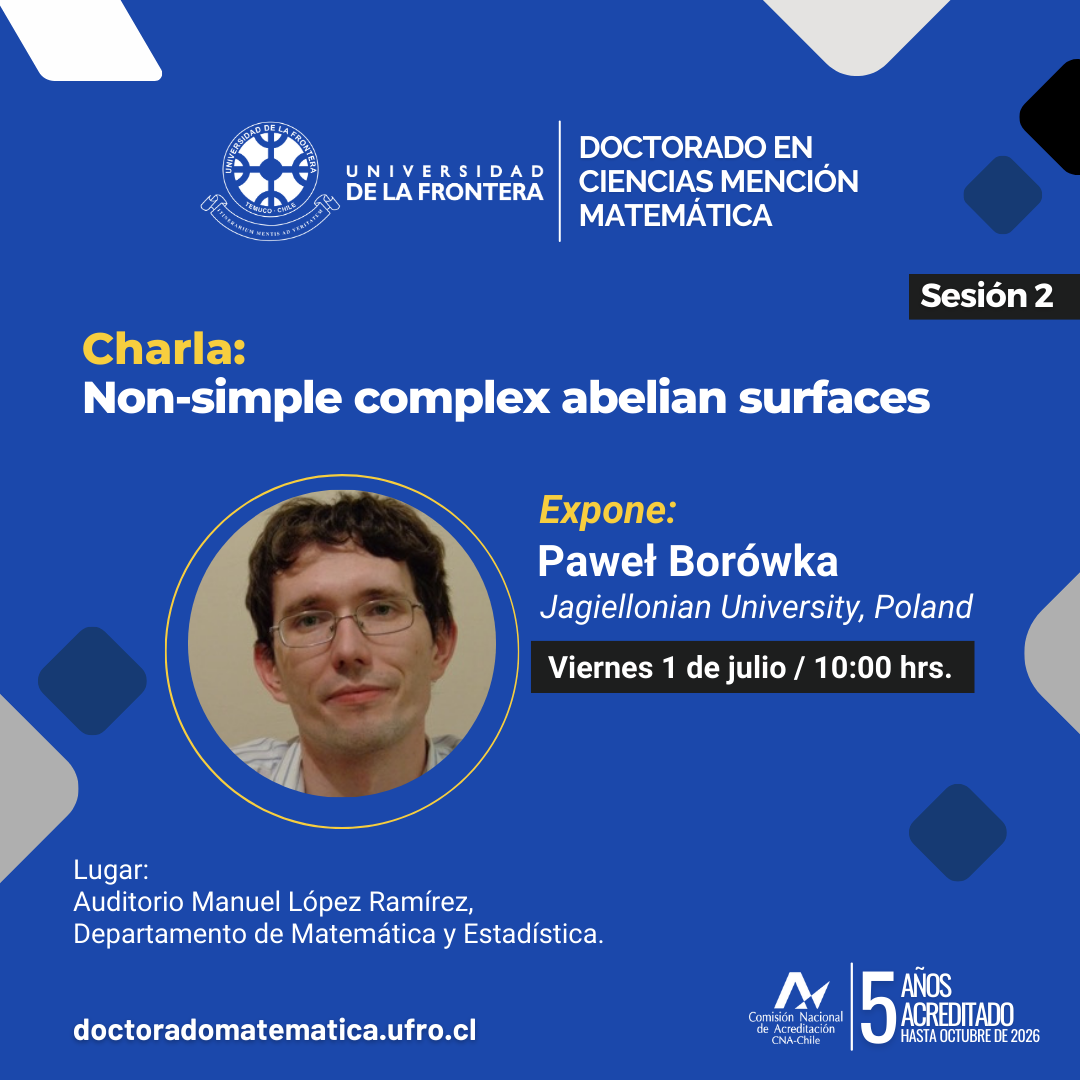
Session 1
Wednesday, June 8 – 3:00 p.m.
ABSTRACT:
When the stored energy density of a hyperelastic material grows slowly to infinity (below |F|^p, with p less than the spatial dimension), it may experience cavitation (the nucleation and sudden growth of internal voids) under high hydrostatic stress [Ball, 1982; James and Spector, 1992]. This represents a failure of quasiconvexity and, therefore, poses a challenge for existence theory in elastostatics [Ball and Murat, 1984]. This obstacle has been overcome under certain coercivity hypotheses [Müller and Spector, 1995; Sivaloganathan and Spector, 2000], which, however, are not satisfied in the paradigmatic example of elasticity: three-dimensional neo-Hookean materials. A joint work with Marco Barchiesi, Carlos Mora-Corral, and Rémy Rodiac will be presented, in which this limiting case was resolved for hollow and axially symmetric domains. Partial results leading to a solution when the axis of rotation is included will also be discussed (where one must prove that the dipoles found by [Conti and De Lellis, 2003] do not minimize energy).
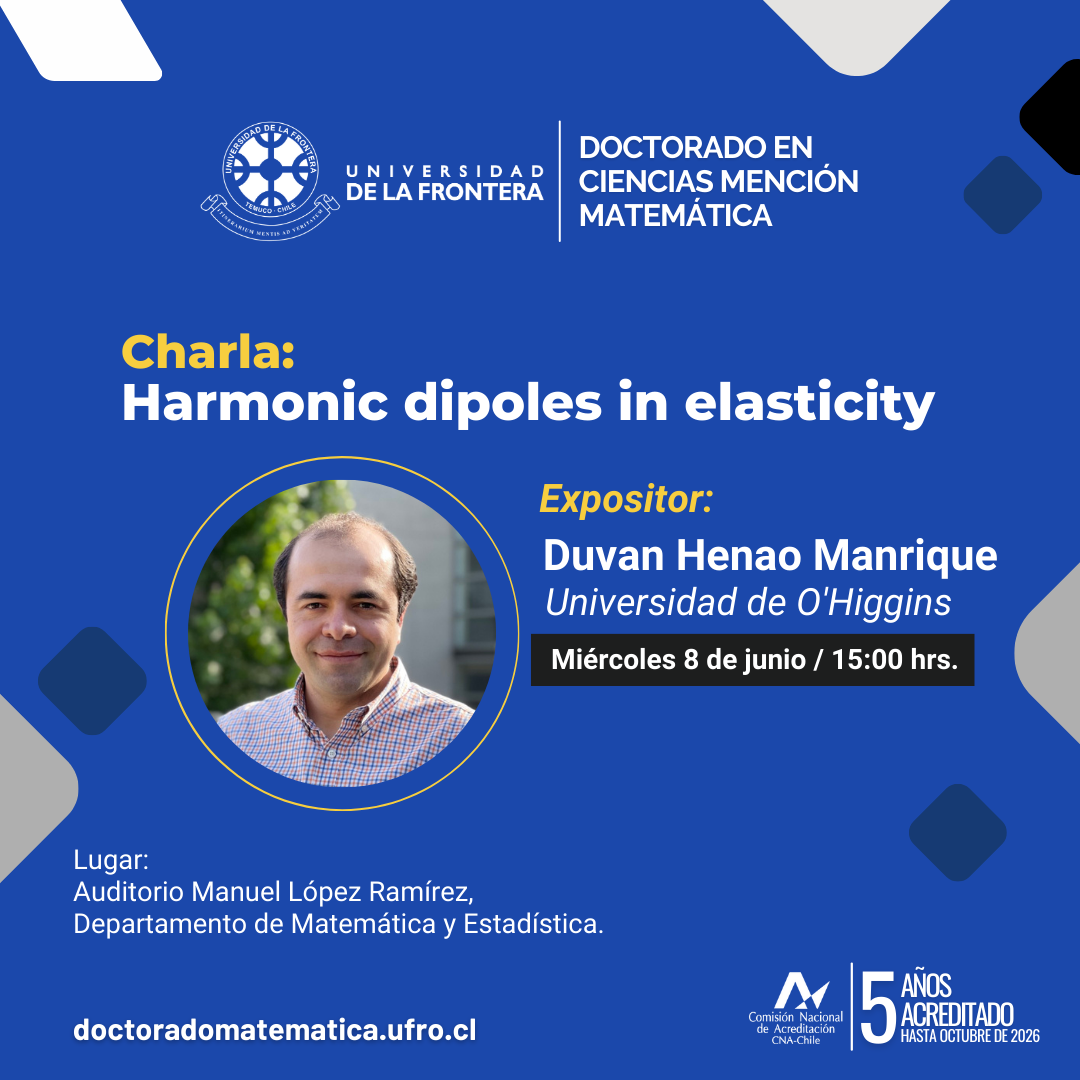
Lecture Series | Session 3
Thursday, January 20 – 4:00 p.m.
ABSTRACT:
We will recall the concepts of generalized Fermat manifolds and their generalized Fermat groups of type (d; k, n) over the field C. Then, we will describe some of the results obtained in [1]. These results concern an algebraic description, the uniqueness of the generalized Fermat group, and a description of the (coarse) moduli space of the generalized Fermat manifolds.
Next, we will introduce the generalized Fermat varieties of type (d; k, n), along with their generalized Fermat groups of the same type, in positive characteristic. We will review some properties, examples, and remarks on these varieties.
Finally, we will present some open questions about these varieties that are part of our research goals, commenting on what is currently known, recent progress, and what remains to be done.
[1] Rubén A. Hidalgo and Maximiliano Leyton-Alvarez. Automorphisms of generalized Fermat manifolds. Preprint, arXiv:2010.04628 [math.AG], 2020.
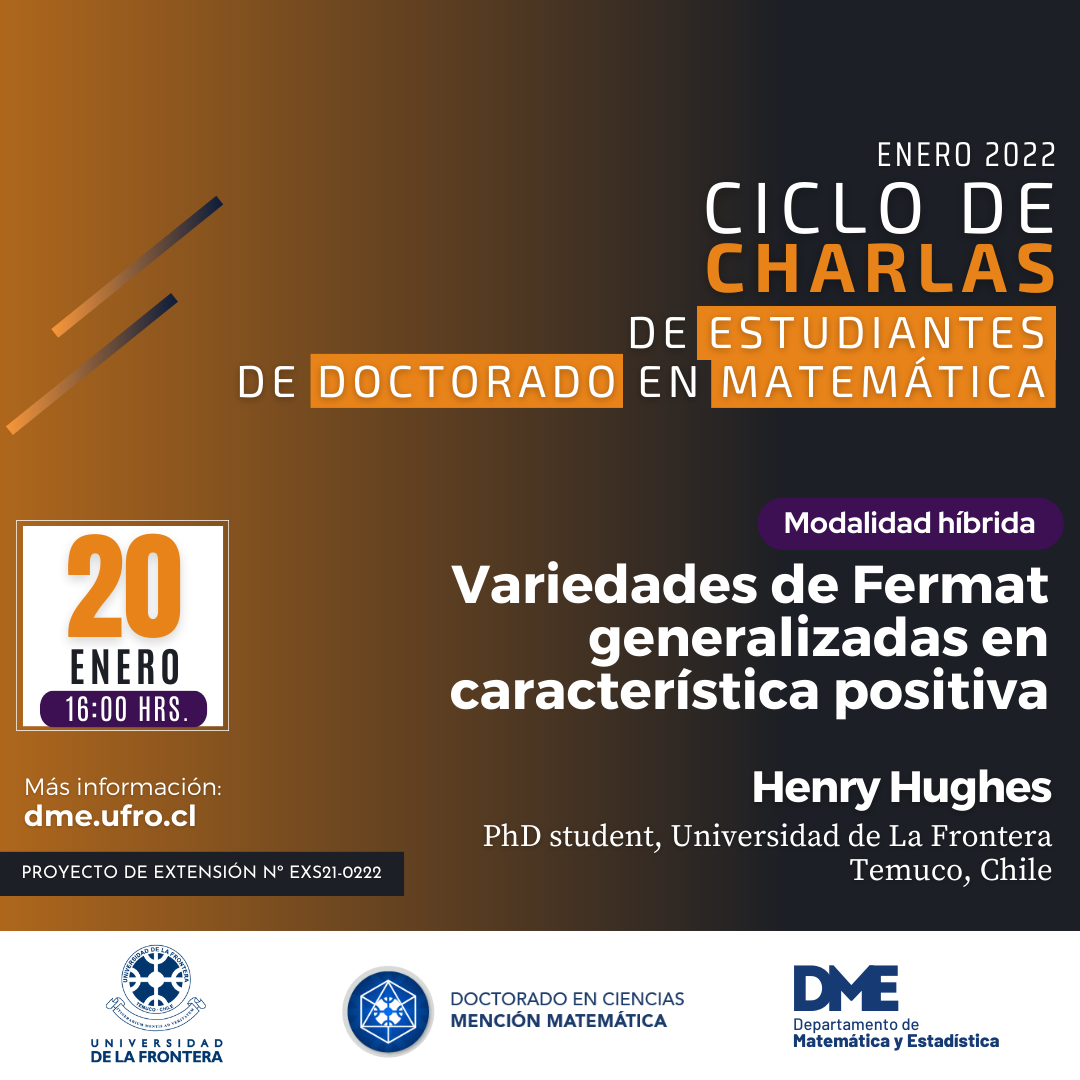
Lecture Series | Session 2
Thursday, January 13 – 4:00 p.m
ABSTRACT:
In this talk, we will introduce a subspace of the space of Hodge cycles of the Fermat variety defined by “simple” arithmetic conditions, called the space of generic Hodge cycles. We will explore some examples and provide a method to explicitly compute a set of generators for this space. As an application, using these explicit Hodge cycles, we will find expressions involving the Gauss hypergeometric function that are algebraic over the field of rational functions in one variable.

Lecture Series | Session 1
Thursday, January 6 – 4:00 p.m.
A Nikulin configuration is the data of 16 disjoint rational curves on a K3 surface. According to Nikulin, the existence of such a configuration on a K3 surface means that this is a Kummer surface. The question of the existence of non isomorphic abelian surfaces giving the same Kummer structures has ever been traited, but it is interesting to construct explicitely the 16 curves. In this talk, we are interested in some classical results about K3 and Kummer surfaces. In particular, we will talk about a work by Xavier Roulleau and Alessandra Sarti which will be the start of the questions that I am studying.
